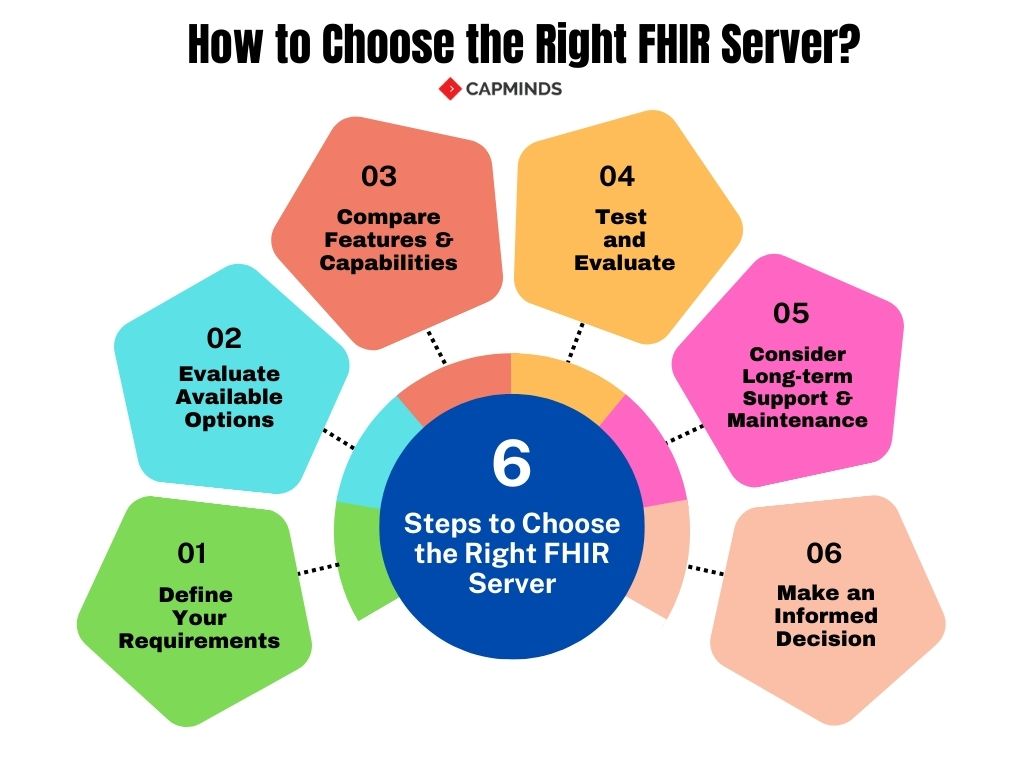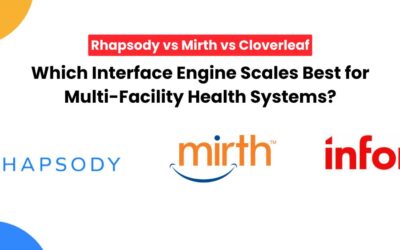Selecting the Right FHIR Server: A Comprehensive Guide
In the ever-evolving landscape of healthcare technology, Fast Healthcare Interoperability Resources (FHIR) has emerged as a game-changer.
RELATED: The Guide to Getting Started with Aidbox Server for FHIR
FHIR servers play a pivotal role in enabling seamless data exchange and interoperability across healthcare systems and applications. Whether you’re a healthcare professional, an IT specialist, or a developer, choosing the right FHIR server is a crucial decision. In this comprehensive guide, we’ll dive deep into the factors and considerations that should influence your choice.
RELATED: HL7 FHIR & EHR Data Transmission: 9 Easy Steps to Implement
Understanding the Basics
Before we embark on the journey of selecting an FHIR server, let’s get a solid grasp of the fundamentals.
What is FHIR?
FHIR, or Fast Healthcare Interoperability Resources, is a modern and flexible standard for healthcare data exchange. It’s designed to make it easier for different healthcare systems to communicate with each other by providing a standardized way to represent and exchange healthcare data.
What is an FHIR Server?
An FHIR server is a piece of software that stores and manages FHIR resources. Think of it as the bridge that connects healthcare applications and systems, allowing them to share patient information in a consistent and structured format.
Now that we have the basics covered, let’s dive into the nitty-gritty of choosing the right FHIR server.
How to Choose the Right FHIR Server?

Step 1: Define Your Requirements
The first and most crucial step in choosing an FHIR server is to define your requirements. Here are some questions to consider:
1. What’s the Scope of Your Project?
- Are you building a new healthcare application or integrating FHIR into an existing system?
- What specific functionalities do you need from the FHIR server?
2. Scalability and Performance
- How many users or systems will access the FHIR server concurrently?
- What are the expected data throughput and response time requirements?
3. Data Storage
- What types of healthcare data will you store (e.g., patient records, lab results, clinical notes)?
- How much data storage capacity do you need?
4. Security and Compliance
- What security protocols and authentication mechanisms are required?
- Does the FHIR server comply with healthcare data standards and regulations (e.g., HIPAA)?
5. Interoperability
- Will the FHIR server support multiple versions of the FHIR standard?
- Does it offer support for other healthcare data exchange standards like HL7?
6. Customization and Extensibility
- Do you need the ability to customize FHIR profiles and resources?
- Is extensibility crucial for your project?
7. Community and Support
- Does the FHIR server have an active and helpful community?
- Are there reliable support options available?
Once you have a clear understanding of your project’s requirements, you can move on to the next step.
Step 2: Evaluate Available Options
With your requirements in mind, it’s time to explore the available FHIR server options. There are several FHIR server implementations to choose from, each with its strengths and weaknesses. Some popular options include:
- HAPI FHIR: HAPI FHIR is an open-source Java-based server that is highly customizable and widely used in the FHIR community. It’s known for its flexibility and support for FHIR profiles
- Microsoft Azure API for FHIR: If you’re looking for a cloud-based solution, Microsoft Azure offers a fully managed FHIR server that integrates seamlessly with other Azure services
- Google Cloud Healthcare API: Google Cloud provides a healthcare API that includes FHIR support. It’s a scalable and secure option for those already invested in the Google Cloud ecosystem
- IBM FHIR Server: IBM’s FHIR server is designed for scalability and high performance. It’s suitable for large healthcare organizations with complex data needs
- Firely Server: Firely’s server is known for its compliance with the latest FHIR specifications and its support for FHIR R4. It’s available in both open-source and commercial versions
- InterSystems HealthShare: InterSystems offers a comprehensive healthcare platform with FHIR support. It’s known for its robust data integration capabilities
- SMART on FHIR: If you’re building an EHR application, SMART on FHIR offers a framework for integrating FHIR data seamlessly into your application
Step 3: Compare Features and Capabilities
Now that you have a list of potential FHIR servers, it’s time to compare their features and capabilities against your project requirements. Here’s what to look for:
- FHIR Version Compatibility: Ensure that the server supports the FHIR version you need (e.g., STU3, R4, or the latest version)
- Data Storage: Evaluate the server’s data storage capabilities, including support for various data types and efficient querying
- Security: Check for robust security features, including authentication, authorization, encryption, and audit trails
- Interoperability: Assess the server’s interoperability capabilities, such as support for multiple standards (e.g., HL7) and data mapping
- Scalability: Consider the server’s scalability and performance under heavy loads
- Customization: If you need to customize FHIR profiles or extend resources, ensure that the server supports these requirements
- Community and Support: Look for an active user community and available support options, including documentation and forums
Step 4: Test and Evaluate
Before making a final decision, it’s essential to test and evaluate the FHIR server. Consider setting up a test environment and conducting the following activities:
- Data Loading: Load sample data into the server to assess how it handles different types of healthcare information
- Performance Testing: Test the server’s performance under realistic conditions, including data retrieval and response times
- Security Testing: Verify that the server meets your security requirements, including authentication and access control
- Interoperability Testing: Ensure that the server can communicate with other healthcare systems and applications effectively
- Customization and Extensibility: Experiment with customizing FHIR profiles and extending resources, if applicable.
Step 5: Consider Long-term Support and Maintenance
Choosing an FHIR server is not just a one-time decision; it’s a long-term commitment. Consider the following factors for long-term support and maintenance:
- Vendor Support: If you’re opting for a commercial solution, assess the vendor’s track record and commitment to updates and support
- Community: An active and engaged user community can provide valuable resources and assistance as you continue to work with the FHIR server
- Upgrades and Compatibility: Ensure that the server can accommodate future FHIR updates and evolving healthcare standards
- Scalability: As your healthcare application grows, the server should scale with it without compromising performance
Step 6: Make an Informed Decision
After a thorough evaluation, you’re ready to make an informed decision. Select the FHIR server that aligns best with your project’s requirements, offers the necessary features and support, and fits within your long-term healthcare technology strategy.
Final Thoughts
Choosing the right FHIR server is a critical step in the journey toward healthcare interoperability and data exchange. By defining your requirements, evaluating options, testing, and considering long-term support, you can make an informed decision that will serve your healthcare project well for years to come. With this comprehensive guide, you now have the knowledge and tools to navigate the complex landscape of FHIR server selection. Remember that the right choice not only ensures seamless data exchange but also contributes to better patient care and healthcare innovation.
As the healthcare industry continues to evolve and embrace digital transformation, your decision regarding FHIR server selection will play a pivotal role in shaping the future of healthcare technology. By staying informed, conducting thorough evaluations, and considering the long-term implications of your choice, you can embark on this journey with confidence.
In a world where healthcare data interoperability is no longer a luxury but a necessity, your informed decision will contribute to a more connected and efficient healthcare ecosystem, ultimately benefiting patients and healthcare professionals alike. Choose wisely, and let your FHIR server be the cornerstone of a healthier, more interconnected future in healthcare.
HL7 Integration Services from CapMinds
CapMinds Technologies offers the perfect all-in-one Health Interoperability solutions for your clinical needs. Our HL7 FHIR services ease the innovatory exchange to create new possibilities. Our client-centered services keep them in the limelight. Our clinical & HL7 integrations enable EHR-integrated laboratory, imaging, e-prescriptions, EPCS, pharmacy, and much more. These enhance the activation process for your individual and collective needs.
“CapMinds Technologies is the place that will make you achieve your goals by combining “Expertise+Hardwork+Commitment”
CapMinds FHIR APIs services cover your patients’ health data with the greatest security, privacy, and confidentiality. We update ourselves with the latest versions like HL7 Version 2, Version 3, HAPI FHIR, SMART on FHIR, CDA, X12, HAPI FHIR, Mirthconnect, and security standards. CapMinds offers the best HL7 integration and HL7/FHIR interface development services for the federal government, health tech startups, laboratories, clinics, and practices.
“Unite with us to get the most benefits of our HL7 integration services and rise to be the first”




